Table of Contents
Creating a calming retreat starts with intentional design. Many people are turning to simple, clutter-free spaces to unwind and recharge. This trend blends functionality with aesthetics, making rooms feel open and peaceful.
Krista Hermanson’s concept of “snuggle spots” aligns with this idea. Small, cozy nooks in a bedroom encourage relaxation without overwhelming decor. Modern design blends this comfort with minimalist principles—think soft textures and warm lighting.
Brands like IKEA have made minimalist furniture accessible. Their sleek, functional pieces prove that simplicity doesn’t sacrifice style. Below, we’ll explore five core ideas from a 15-point framework to transform your home into a serene retreat.
1. Embrace a Neutral Color Palette
Color sets the mood in any space, and neutral tones create instant calm. Designers like Brian Ferry layer soft whites with textured throws, proving simplicity feels luxurious. A restrained palette lets furniture and lighting shine while keeping walls quietly elegant.
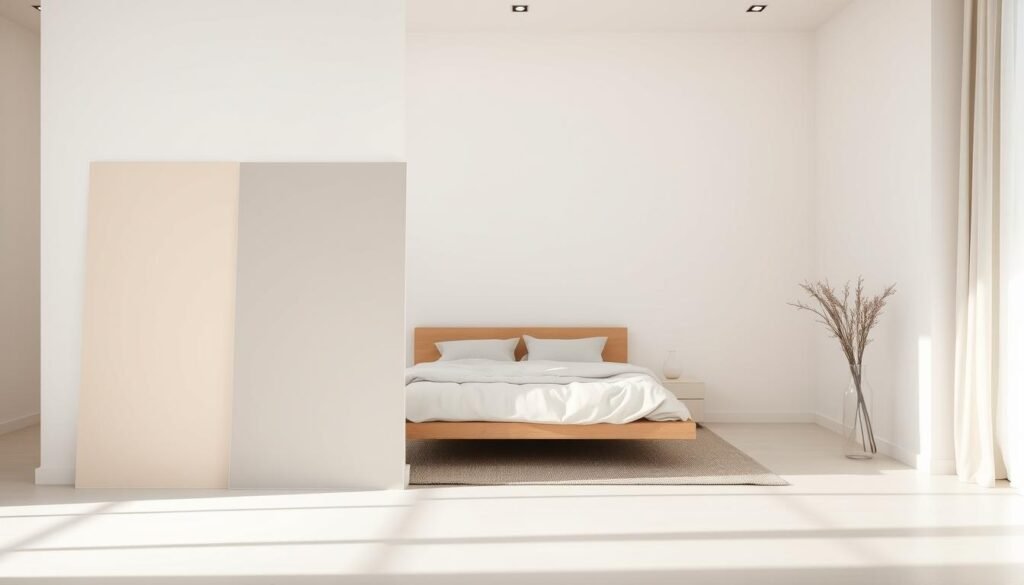
Soft Whites and Creams
Showcase Home Studios uses all-white bedding with linen throws for depth. Benjamin Moore’s White Dove OC-17 is a go-to base shade—warm but not stark. As designer Jessica Nelson notes, matching undertones to wood finishes avoids a sterile look.
Warm Earth Tones
Elisa Baran’s limewash paint colors add organic texture.
“Limewash lets walls breathe, creating a soft, weathered effect,”
she explains. Pair these with Tobias Petri’s navy accents (like his alpine retreat) for subtle contrast.
Cool Grays and Blues
Cool tones expand small spaces visually. Jessica Nelson suggests testing swatches at different times of day—gray can shift from blue to green undertones. For cohesion, pick one dominant color and two supporting hues.
2. Opt for Simple, Functional Furniture
Functional pieces blend style and practicality in modern design. The right furniture maximizes space while maintaining a clean aesthetic. Designers like Marie Flanigan prioritize low-profile silhouettes to create harmony.
Low-Profile Bed Frames
Platform Bed Co.’s floating bed frames with built-in lighting add modern flair. Brownstone Boys’ sculptural designs prove simplicity can be striking. For small spaces, IKEA’s MALM series offers hidden storage compartments.
Multi-Functional Nightstands
Kristin Fine’s acrylic nightstands maintain an airy feel.
“Transparent materials visually expand tight spaces,”
she notes. Opt for pieces with drawers or shelves to reduce surface clutter.
Minimalist Storage Solutions
Bench seats with lift-up compartments at the foot of the bed double as seating and storage. Built-in shelves or under-bed bins keep essentials out of sight. The goal? A serene space where every item has purpose.
3. Keep Decor Minimal and Intentional
Thoughtful decor elevates a space without overwhelming it. Focus on pieces that serve a purpose or spark joy. Every item should contribute to the room’s design and calm vibe.
One Statement Piece
Mark Grattan’s Art Deco-inspired bed frame proves bold doesn’t mean busy. Its striped upholstery adds visual interest while keeping the room airy. Pair it with neutral walls to let it shine.
Subtle Textures
Layer tactile elements for depth:
- CB2’s ribbed ceramic vases add organic contrast.
- Ecru Studio mixes silk and wool pillows for cozy contrast.
Natural Elements
Nate Berkus’ rattan cactus brings warmth without clutter. Wooden trays or a single potted plant work too. Remember: surfaces look best with just 3 accessories max.
“Edit ruthlessly—if it doesn’t serve function or beauty, it doesn’t belong.”
4. Maximize Natural Light
Natural light enhances both the mood and functionality of a space. It brightens the entire room, reduces the need for artificial lighting, and makes small areas feel larger. A few strategic tweaks can amplify sunlight’s impact.
Sheer Curtains
Restoration Hardware’s linen sheers filter light softly while maintaining privacy. Mount rods 12″ above window frames to create height and draw the eye upward. For UV protection, 3M’s window film blocks rays without darkening the design.
Mirrors to Reflect Light
Designer Sarah Solis places mirrors opposite windows to bounce light across the floor. A large, frameless mirror adds visual interest while doubling sunlight’s reach. Round House’s suspended bed frame (with mirrored panels underneath) is another clever twist.
Unobstructed Windows
Round House’s floor-to-ceiling window walls flood rooms with sunlight. Keep sills clear of bulky decor—opt for a single plant or slim vase instead. If privacy’s a concern, frosted glass or top-down shades offer solutions without sacrificing light.
5. Reduce Visual Clutter
The secret to a peaceful room lies in eliminating distractions. When surfaces stay clear and every item has purpose, your space automatically feels calmer. As designer Rushda Hakim advises,
“Edit ruthlessly—if it doesn’t spark joy or serve function, let it go.”
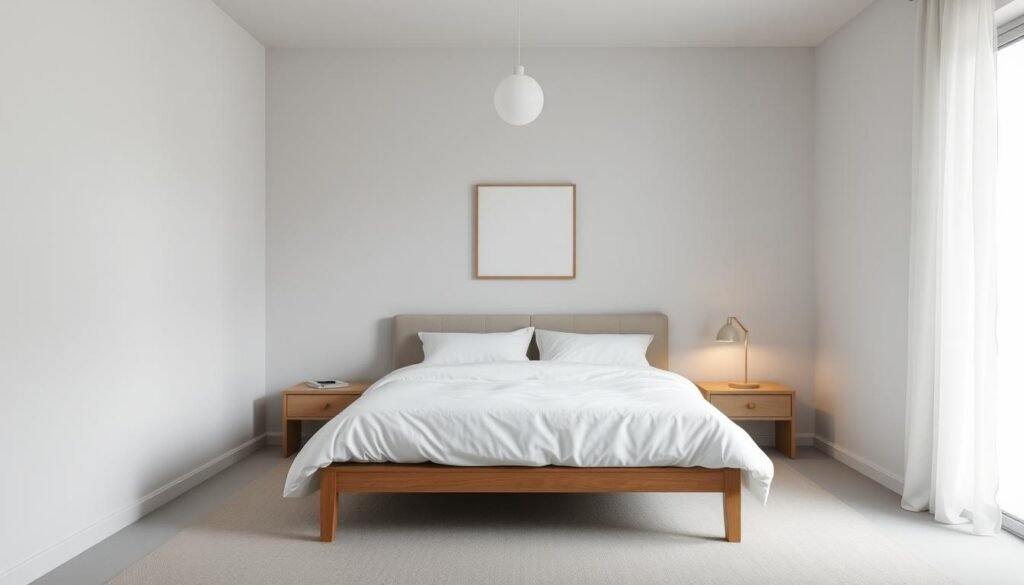
Hidden Storage
Karin Meyn’s Amsterdam apartment showcases brilliant hidden storage solutions. Her floor-to-ceiling partition wall doubles as shelving with discreet cabinets. For smaller spaces, The Container Store’s under-bed vacuum bags protect seasonal items while saving space.
Limited Accessories
West Elm’s streamlined dressers with soft-close drawers keep essentials organized but out of sight. Stick to the 1-3-5 rule: one focal piece, three medium decor items, and five small accents per room. This creates balance without visual clutter.
Clean Lines
Simple furniture silhouettes maintain order. Choose pieces with smooth surfaces and minimal detailing. A 10-minute nightly decluttering routine prevents accumulation—return stray items to their designated spots before bed.
6. Choose a Minimalist Bed Frame
The right bed frame anchors your space with clean lines and purpose. It’s the focal point of your room, so opt for designs that balance aesthetics and practicality. From platform beds to floating styles, each choice impacts the room’s flow.
Platform Beds
Thuma’s Japanese joinery platform beds combine elegance and durability. Their modular design requires no tools for assembly—perfect for renters. Silvio Rech’s linen-draped floor bed (shown above) proves low-profile furniture can feel luxurious.
Floating Beds
Floating bed frames create illusion of space by elevating the mattress. Brands like Zinus offer affordable options with built-in storage. For premium quality, Casper’s reinforced slats ensure long-term support.
Low-Profile Designs
Marie Flanigan’s whitewashed wood frames blend seamlessly with neutral floor tones. Keep 14″ clearance underneath for easy cleaning or storage bins. This style works especially well in small rooms.
| Brand | Style | Key Feature |
|---|---|---|
| Thuma | Platform | Tool-free assembly |
| Zinus | Floating | Budget-friendly |
| Casper | Low-Profile | Reinforced slats |
7. Incorporate Subtle Patterns
Subtle designs add depth without overwhelming the eye. When chosen carefully, patterns create visual interest while maintaining a serene aesthetic. The key is restraint—let one or two elements shine against clean backgrounds.
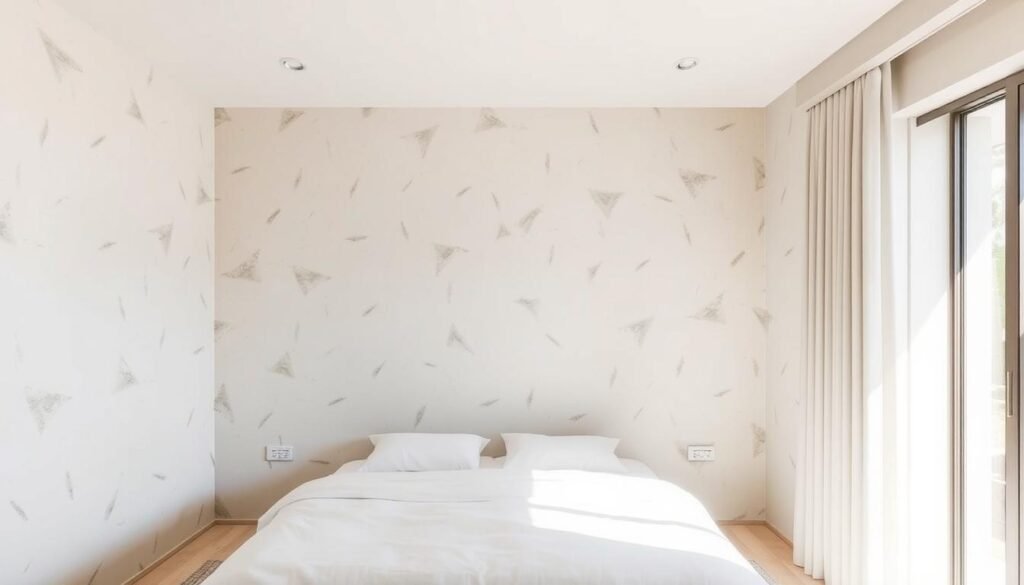
Geometric Prints
Wendy Labrum’s taupe gingham walls prove small-scale prints work in minimalist spaces. For floors, Anthropologie’s tone-on-tone geometric rugs add texture without chaos. Stick to monochromatic schemes—gray hexagons on white, or beige triangles on cream.
Subtle Stripes
Serena & Lily’s tonal stripe bedding pairs perfectly with Mark Grattan’s Art Deco bed frame.
“Vertical stripes elongate low ceilings, while horizontal ones widen narrow walls,”
notes textile designer Lila Cohen. For cohesion, match stripe colors to existing furniture tones.
Monochromatic Textures
Layer fabrics with different tactile qualities:
- Crinkled linen pillowcases against smooth percale sheets
- Nubby wool throws over silky cotton duvets
Limit patterned surfaces to 20% of the room. This maintains balance—like a single accent wall or textured area rug on hardwood floors.
8. Use Monochromatic Schemes
Monochromatic schemes bring harmony by using shades of a single color. This approach simplifies design while creating a polished aesthetic. Tobias Petri’s navy throws (shown below) demonstrate how accents add depth without clutter.
All-White Rooms
Sherwin-Williams’ Alabaster SW 7008 is a warm white base for layered textures. Designer Ezz Wilson pairs it with terracotta bedding for subtle contrast. Avoid flatness by mixing finishes—glossy trim with matte walls.
Single Color Accents
Farrow & Ball’s tonal palette collections simplify matching. Stick to three shades: a base, mid-tone, and accent. For example:
- Base: Pale gray (Wimborne White)
- Mid-tone: Dusty blue (Hague Blue)
- Accent: Navy velvet pillows
Consistent Tones
Ezz Wilson’s rust-hued rug ties into terracotta vases for cohesion.
“Vary textures—linen, ceramic, wood—to keep single-color spaces dynamic,”
he advises. This trick prevents monotony while maintaining calm.
9. Focus on Quality Over Quantity
Investing in fewer, better-made items elevates your home effortlessly. Well-crafted pieces save time and money long-term, blending function with enduring style. As Krista Hermanson notes:
“Drapery or bedding in natural fibers ages beautifully—like a favorite leather jacket.”
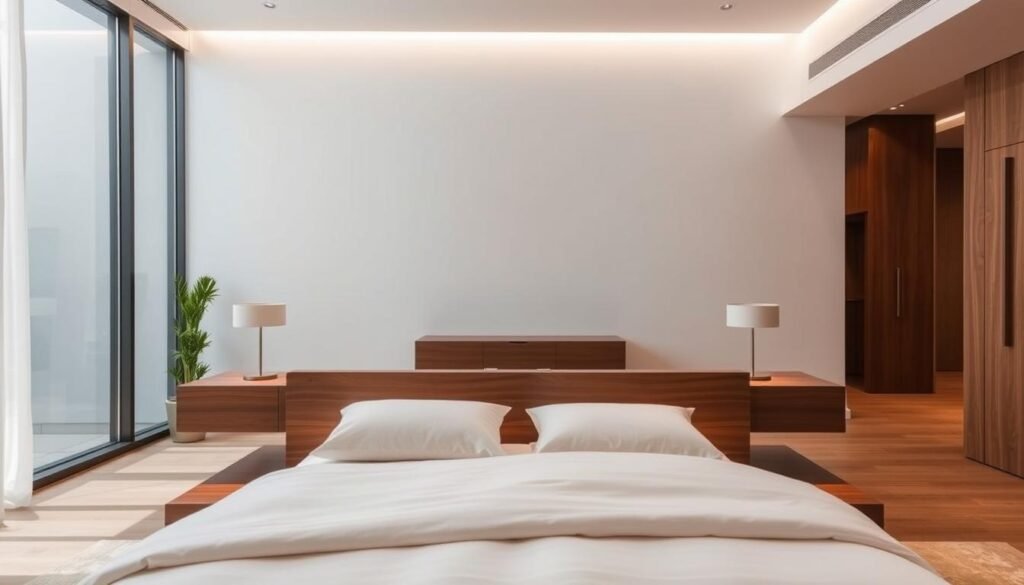
High-Quality Bedding
Parachute’s 100% French flax linen softens with each wash, proving luxury needn’t be high-maintenance. For temperature regulation:
- Cotton percale: Crisp and breathable (ideal for hot sleepers).
- Bamboo blends: Silky and moisture-wicking.
| Material | Durability | Best For |
|---|---|---|
| Linen | 10+ years | Year-round comfort |
| Egyptian Cotton | 8-12 years | Cool, smooth feel |
Durable Furniture
Hardwood frames outlast veneers by decades—Cochineal Design’s scalloped headboard showcases craftsmanship. Herman Miller’s 12-year warranty underscores reliability. Key tests:
- Joint stability (wiggle test).
- Finish resistance to scratches.
Timeless Pieces
Choose items that adapt to trends. A neutral sofa or oak desk works in any design era. As designer Lila Cohen advises:
“If it won’t look good in 10 years, skip it.”
Prioritize versatility—like a modular shelving system or convertible daybed.
10. Create a Calming Atmosphere
Lighting and scents play a key role in crafting a serene room. The right ambiance makes your space feel like a retreat, blending function with relaxation. Focus on soft lighting, soothing fragrances, and sound control for harmony.
Soft Lighting
Victoria Ninette’s frosted globe chandeliers cast a gentle glow. Dimmable fixtures let you adjust brightness for reading or winding down. Reena Simon integrates wood-framed sconces for a warm, natural aesthetic.
- Use warm bulbs (2700K–3000K) to avoid harsh light.
- Layer sources: floor lamps + bedside lights.
Calming Scents
Pura’s smart diffusers release sleep blends like lavender and cedarwood.
“Scents trigger relaxation—opt for subtle, natural fragrances,”
says aromatherapist Leah Garcia. Avoid synthetic sprays; try essential oil rollers instead.
Quiet Spaces
Soundproof Cow’s acoustic panels reduce noise for uninterrupted rest. Aim for under 30 decibels—equivalent to a whisper. Soft rugs and heavy curtains absorb echoes for a peaceful feel.
- White noise machines mask outdoor sounds.
- Place beds away from noisy walls or windows.
11. Opt for Minimalist Wall Art
Wall art should complement your space, not dominate it. The right pieces add visual interest while keeping the room serene. Focus on quality over quantity—let each artwork breathe.
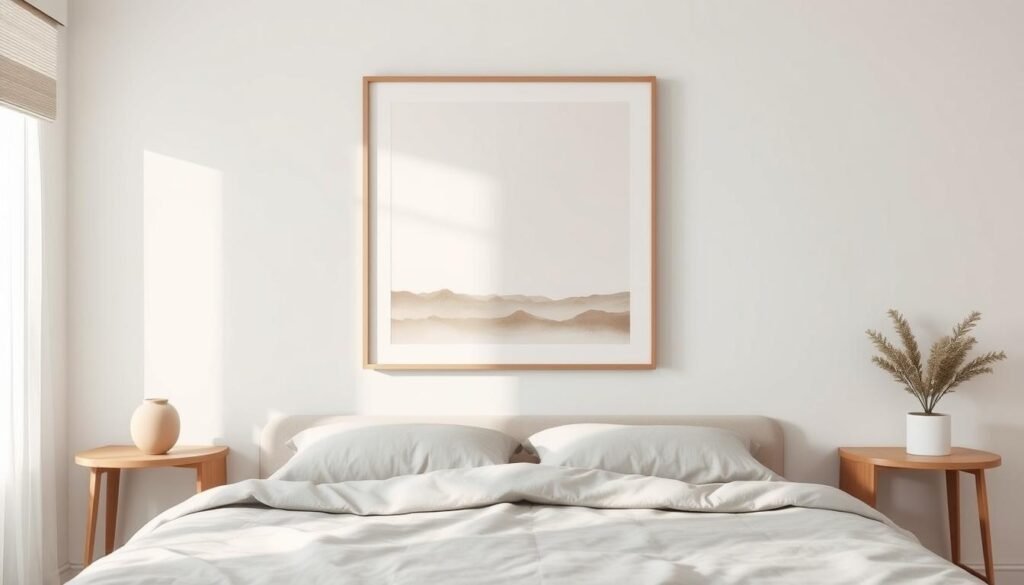
Single Large Piece
Richard Aldrich’s abstract work in the Hamptons proves scale matters. A bold painting or photograph becomes the room’s anchor. Minted’s oversized canvases offer affordable options for this look.
Follow the 60/40 rule: artwork should cover 60% of the wall space, leaving 40% empty. This balance prevents overcrowding.
Neutral Artwork
Elaine Santos’ unframed landscapes blend into muted design schemes effortlessly. Stick to black-and-white or earthy tones for cohesion. Textured paper or canvas adds depth without color clashes.
Frameless Prints
Modern spaces shine with floating acrylic or canvas wraps. They create clean lines and reflect light subtly. Avoid gallery walls in sleeping zones—they distract rather than relax.
| Art Style | Best For | Example |
|---|---|---|
| Abstract | Statement walls | Richard Aldrich |
| Neutral Prints | Small spaces | Elaine Santos |
| Frameless | Modern aesthetics | Minted Canvas |
12. Keep Flooring Simple
Flooring sets the foundation for a clean, cohesive space. The right choice enhances both aesthetics and functionality. Designers like Reena Simon use rough-sawn hardwood to add texture without clutter.
Hardwood Floors
Reena Simon’s wide-plank oak floors prove timeless appeal. Lighter stains make small rooms feel airy, while matte finishes hide scratches. For durability, opt for engineered wood in humid climates.
Neutral Rugs
Lance Gerber’s geometric wool rug in Palm Springs adds subtle look. Wool resists wear, while jute offers eco-friendly texture. Layer rugs over hardwood for warmth—just leave an 18″ bare perimeter around the bed.
Minimalist Carpets
FLOR’s modular tiles are a renter-friendly way to customize. Choose low-pile styles for easy cleaning. For wall-to-wall, stain-resistant nylon blends mimic the floor’s simplicity without sacrificing comfort.
13. Use Lighting Strategically
Smart lighting transforms a room from functional to inviting with just a flip of a switch. The right balance enhances both the design and feel of your space. From recessed lights to bold chandeliers, each layer serves a purpose.
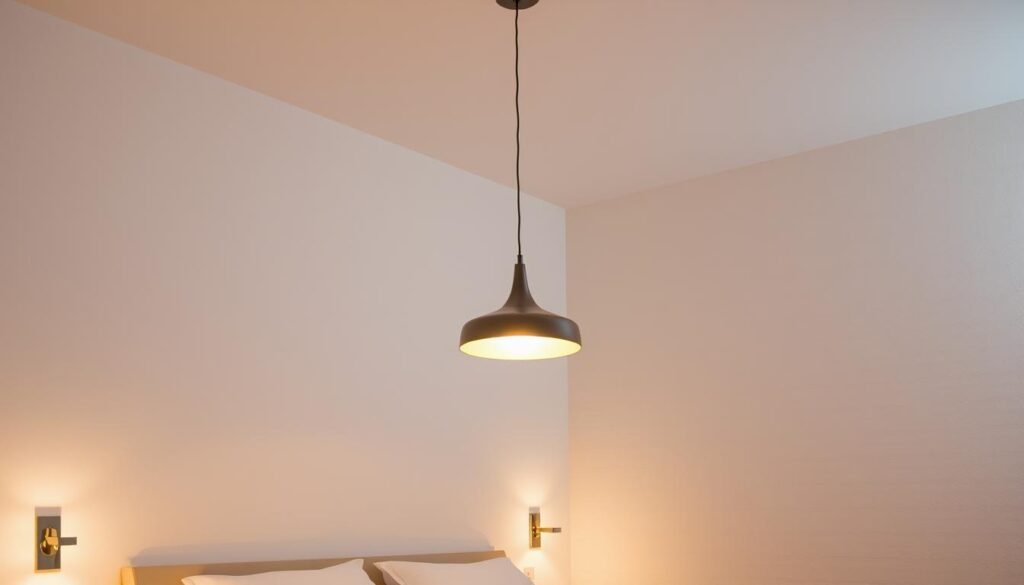
Recessed Lighting
Recessed lights offer a clean look without bulky fixtures. Place them 2–3 feet apart for even illumination. Pair with dimmers to adjust brightness for reading or relaxing.
Statement Fixtures
Elaine Santos’ tiered chandelier proves lighting can be art. Choose one focal piece—like a sculptural pendant—to anchor the room. Keep other fixtures simple to avoid visual competition.
Dimmable Lights
Philips Hue’s circadian system syncs with natural light cycles. Opt for 2700K–3000K bulbs for warmth.
“Layered lighting zones—ambient, task, accent—create depth and flexibility,”
says designer Victoria Ninette. Avoid overlighting; 50–75 watt equivalents are ideal for most spaces.
- Ambient: Overhead or wall-mounted for general light.
- Task: Bedside lamps or under-cabinet strips.
- Accent: Spotlights to highlight art or textures.
14. Prioritize Comfort
The best designs prioritize how a space feels, not just how it looks. From plush bedding to ergonomic seating, every detail should invite relaxation. South African architect Silvio Rech’s linen-draped designs prove simplicity and comfort go hand in hand.
Luxurious Bedding
Silvio Rech’s organic linen bedding softens with time, blending durability with tactile warmth. For cooler options, Saatva’s organic cotton sheets offer breathability. Layer textures:
- Euro shams for back support
- Down-alternative pillows for allergy sufferers
| Material | Benefits | Best For |
|---|---|---|
| Linen | Temperature-regulating | Year-round use |
| Organic Cotton | Hypoallergenic | Hot sleepers |
Ergonomic Furniture
Herman Miller’s reading chair supports posture without sacrificing style. Look for:
- Adjustable lumbar support
- Armrests at desk height
“Furniture should adapt to your body, not the other way around.”
Cozy Textiles
Weighted blankets with OEKO-TEX-certified fabrics reduce stress safely. Krista Hermanson’s drapery adds softness—opt for blackout linens if light disrupts sleep. Balance warmth with breathability for all-season comfort.
15. Maintain a Clutter-Free Space
A tidy room starts with smart habits and intentional choices. Keeping surfaces clear and items organized creates a peaceful way to enjoy your home. Small daily efforts prevent overwhelming messes.
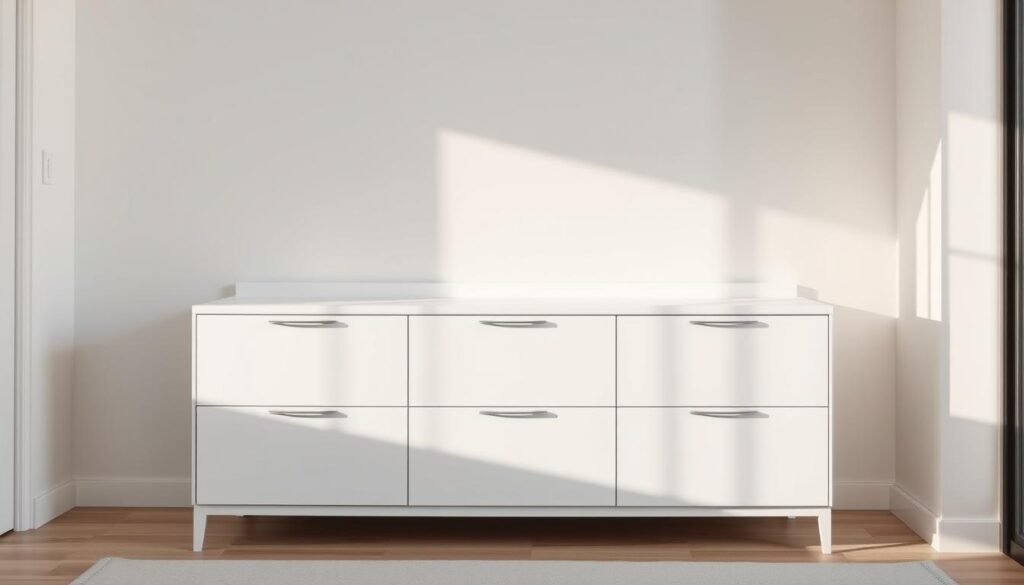
Daily Decluttering
Liz Dutton’s inward-spine book display keeps shelves neat while showcasing favorites. Try the 12-12-12 challenge: remove 12 items to donate, 12 to trash, and 12 to relocate daily. This quick routine prevents accumulation.
Nate Berkus uses labeled bins for kids’ toys—a system that works for adults too. His storage solution proves functionality can be stylish. Designate specific spots for frequently used things to cut cleanup time.
Smart Storage
The IKEA PAX system with custom inserts maximizes closet space efficiently. Consider these options:
- Pull-out drawers for folded clothes
- Adjustable shelves for seasonal items
- Belt racks for quick access
Under-bed containers with wheels make retrieving items effortless. For small things, acrylic dividers keep drawers orderly without visual weight.
Minimalist Mindset
Adopt the “touch it once” rule—handle items immediately instead of setting them down. Designer Liz Dutton advises:
“If it takes less than a minute, do it now. Delayed decisions create clutter.”
Regular edits ensure your space stays functional. Every season, reassess what deserves a spot. Quality over quantity keeps rooms serene.
| Storage Solution | Best For | Tip |
|---|---|---|
| IKEA PAX | Closets | Add lighting inside |
| Under-bed bins | Seasonal items | Use clear labels |
| Acrylic dividers | Small accessories | Group by category |
Conclusion
A peaceful home starts with balance—Rushda Hakim’s “warm minimalism” proves less can feel inviting. Her approach blends clean lines with cozy textures, turning any space into a retreat.
From neutral palettes to smart storage, these five ideas simplify your design process. Start small: swap bulky furniture first, then edit decor weekly. Trends like curved silhouettes add softness without clutter.